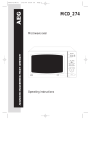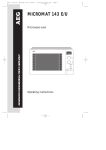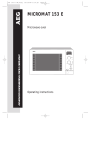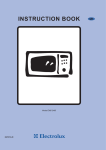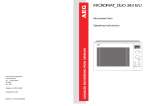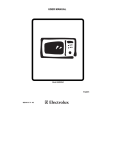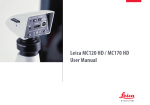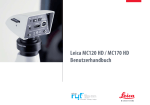Download AEG MC_170 Operating instructions
Transcript
1/12/99 10:30 am Page 1 MC_170 Microwave oven ADVANCED ENGINEERING FROM GERMANY MC170,UK(2) 900W E Operating instructions MC170,UK(2) 1/12/99 10:30 am Page 2 Dear customer, Thank you for buying an AEG microwave oven and putting your trust in the AEG brand name. Before using your AEG microwave for the first time, please read the instruction book thoroughly. This will enable you to take advantage of all the features that the appliance offers. It will also ensure trouble-free operation and minimize unnecessary service calls. 1 Important information concerning your safety or the operation of your appliance is noted by this symbol and/or mentions such as «Warning», «Take care». Be sure to follow all instructions carefully. 0 Throughout the manual, this symbol assists you in the proper use of your appliance. 3 This symbol indicates further information concerning the use of the appliance. 2 The clover indicates energy-saving tips and hints for environmentally friendly use of your appliance. In the event of malfunctioning, please follow the instructions given in the section «What to do if...» 2 MC170,UK(2) 1/12/99 10:30 am Page 3 UK Contents Important information Ecologically responsible disposal of packaging and old appliances . . . . . . . . . . . . . . . . . . . . . . . . . . . . . . . . . 4 Safety Instructions General . . . . . . . . . . . . . . . . . . . . . . . . . . . . . . . . . . . . . . . . . For trouble free and safe operation . . . . . . . . . . . . . . . . . . Microwaves . . . . . . . . . . . . . . . . . . . . . . . . . . . . . . . . . . . . . 5 5 6 General operating instructions Suitable ovenware . . . . . . . . . . . . . . . . . . . . . . . . . . . . . . . . What else to look out for.. . . . . . . . . . . . . . . . . . . . . . . . . . 8 9 Installation and Connection Installation.. . . . . . . . . . . . . . . . . . . . . . . . . . . . . . . . . . . . . Connecting to the mains . . . . . . . . . . . . . . . . . . . . . . . . . . Electrical Connections . . . . . . . . . . . . . . . . . . . . . . . . . . . . 9 10 11 Product Description The Appliance . . . . . . . . . . . . . . . . . . . . . . . . . . . . . . . . . . . Control panel . . . . . . . . . . . . . . . . . . . . . . . . . . . . . . . . . . . Accessories . . . . . . . . . . . . . . . . . . . . . . . . . . . . . . . . . . . . . . 12 13 14 “At a glance” operating instructions . . . . . . . . . . . . . . . . 15 Cooking charts and Tips Microwave Power setting Guide . . . . . . . . . . . . . . . . . . . . . Defrosting instructions using 180W . . . . . . . . . . . . . . . . . . Tips on microwaving . . . . . . . . . . . . . . . . . . . . . . . . . . . . . . 16 17 18 Cleaning and Care . . . . . . . . . . . . . . . . . . . . . . . . . . . . . 20 What to do if... . . . . . . . . . . . . . . . . . . . . . . . . . . . . . . . . 21 Service Information . . . . . . . . . . . . . . . . . . . . . . . . . . . . 22 Technical Data . . . . . . . . . . . . . . . . . . . . . . . . . . . . . . . . 23 Comet After Sales Service . . . . . . . . . . . . . . . . . . . . . . . . . . . . . Back Cover 3 MC170,UK(2) 1/12/99 10:30 am Page 4 Important information 2 Ecologically responsible disposal of packaging materials and old appliances Packaging materials 1 2 AEG microwave ovens require effective packaging to protect them during transportation. Only the minimum packaging necessary is used. Packaging materials (e.g. foil or styrofoam) can place children at risk. Danger of suffocation. Keep packaging material away from children. All packaging materials used are environment friendly and recyclable. The cardboard is made from recycled paper and the wooden parts are untreated. Plastic items are marked as follows : «PE» polyethylene eg packaging film «PS» polystyrene eg packaging (CFC-free) «PP» polypropylene eg packaging straps By using and re-using the packaging, raw materials are saved and waste volume is reduced. Packaging should be taken to your nearest recycling centre. Contact your local council for information. Disposal of old appliances 2 4 Old appliances should be made safe before disposal by removing the plug, and cutting off and disposing of the power cable. It should then be taken to the nearest recycling centre or returned to your electrical retailer, who may dispose of it for a small charge. MC170,UK(2) 1/12/99 10:30 am Page 5 UK Safety instructions 1 General ·The appliance should only be operated with the turntable and turntable support inserted. ·Only suitable microwave ovenware should be used. ·To protect the appliance against corrosion from moisture (condensation) in the cavity or on the door, wipe these areas dry after each use. ·Do not leave the appliance unattended when warming or cooking food in disposable containers made of plastic, paper, or other flammable materials. 1 ·If smoke is observed, keep the oven door closed and disconnect the power supply. Never use the microwave oven if it is no longer functioning properly. ·This appliance complies with all relevant safety instructions. In order to maintain the safety of the appliance, repairs should only be carried out by a fully qualified electrician, trained by the manufacturer. Repairs carried out by unqualified electricians can place the user in severe danger. In the case of any defect or breakdown, please therefore contact your local electrical dealer or the Comet Service Department directly. ·Should the door seals and/or door seal surfaces be damaged, the appliance should not be operated until it has been repaired by the Comet Service Centre or by an AEG-trained electrician. ·Damaged appliance parts can only be replaced by exactly the same make of parts. Special tools are required for this operation. ·WARNING : Do not allow children to use the microwave oven without supervision unless they have been thoroughly instructed in . the proper use and the dangers of improper operation For trouble free and safe operation ·Never jam anything between the door and the door frame. ·Always keep the door seals and their surfaces clean. ·Do not keep any flammable items in the microwave. They could ignite when the unit is switched on. ·Switch the appliance on only when the food has been placed inside the cooking space, as it could overload if there is no food present. 5 MC170,UK(2) 1/12/99 10:30 am Page 6 Safety instructions Microwaves 1 · When heating liquids, e.g. soups, sauces and beverages in your microwave oven, overheating the liquid beyond boiling point can occur without evidence of bubbling. This could result in a sudden boil over of the hot liquid - with the risk of scalding the user. To prevent this possibility the following steps should be taken: 1. Avoid using straight-sided containers with narrow necks. 2. Do not overheat. 3. Stir the liquid before placing the container in the oven and again halfway through the heating time. 4. After heating, allow to stand in the oven for a short time, stirring again before carefully removing the container. · Food with «skin» or «peel», such as potatoes, tomatoes, sausages, and the like, should be pierced with a fork so that any steam present can escape and the food will not burst. · Make sure that a minimum temperature of 70°C is attained for the cooking/heating of food. Never use a mercury or liquid thermometer for measuring the temperature of the food. · Baby food in jars or bottles should always be heated without a lid or top, and well stirred or shaken after heating, to ensure uniform distribution of the heat. Always check the temperature before feeding your child. · The hot food in a microwave oven will heat up the ovenware. For this reason always use oven gloves for handling hot dishes. · Never cook your food for too long or at too high a power setting. Some areas of the food can dry out or even ignite. 6 MC170,UK(2) 1/12/99 10:30 am Page 7 UK 1 Do not use your microwave oven for the following : · to boil eggs or escargots in their shells, as they will burst. Eggs can be poached or «fried» in a microwave oven as long as the yolks are pricked. · to heat large quantities of cooking oil (fondue or deep frying) and drinks containing a high percentage of alcohol - there is danger of spontaneous combustion! · to heat unopened cans, bottles, etc. · to dry animals, textiles or paper. · for crockery like porcelain, ceramics, or porous earthenware (e.g. on the handles or unglazed bases) that can fill up with water. This can cause vapour pressure to build up during cooking which could shatter the dish. 7 MC170,UK(2) 3 1/12/99 10:30 am Page 8 General operating instructions Suitable ovenware Ovenware material Mode of operation Defrosting Ovenproof glass and ceramic dishes (without any metal parts, e.g. Pyrex, Oven-to-tableware) Non ovenproof glass and porcelain (e.g. table crockery)1) Glass ceramic and vitro-ceramic made of fire/frost proof material (e.g. Arcoflam) Ovenproof earthenware 2) Plastic, heat-resistant up to 200°C 3) Paper, cardboard Cling film Microwave cling film 3) Black-lacquered or silicone-coated baking tins X suitable 1) Heating Cooking X X X X - - X X X X X X X X X X X X - X - X - - non suitable excluding silver, gold, platinum or metal decoration 2) does not include glaze containing metal 3) please note the maximum temperature stated by the manufacturer 8 MC170,UK(2) 1/12/99 10:31 am Page 9 UK 3 What else to note... · Food comes in all shapes, sizes and textures. The quantities also vary. For these reasons the time and amount of energy needed to defrost, heat or cook will also vary. As a general rule : Double the power = nearly half the time Please refer to the cooking charts. To be on the safe side, always select the shorter cooking time. Then extend the time as necessary. · Microwaves work by making the food heat itself up. Because of this, not all areas of the food will be heated at the same time. When heating larger quantities of food, it is particularly important to stir or turn them over. · “Standing time” is referred to in the cooking charts. This is the time you should leave the food to stand without power (either inside or outside the appliance). This ensures even distribution of heat throughout the food. Installation and Connection 200mm 50mm Installation A gap all around the oven is necessary in order to ensure perfect ventilation: 200 mm above the oven and any objects, 50mm on the sides and behind the oven. This appliance complies with the following EC Directives : EMC Directive 89/336/EEC, Low Voltage Directive 73/23/EEC with amendment 90/683/EEC and the CE marking Directive 93/68/EEC. 9 MC170,UK(2) 1/12/99 10:31 am Page 10 Installation and Connection Installation 1. Remove any promotion label from the door. 2. Install the oven on a flat, level surface. The surface must be strong enough to safely bear the weight (22 kg) of the oven, and the contents. To avoid the possibility of causing vibration or noise the oven must be in a stable position. 3. Keep the oven away from heat and water. Exposure to heat and water can lower oven efficiency and lead to malfunctioning, so be sure to install the oven away from heat and water sources. 4. Do not block air vents on the top and the sides of the cabinet and also do not place any articles on the top of the oven. If air vents are blocked during operation, the oven may overheat, and this may lead to malfunctioning. Hot air escapes from the vents, so be sure not to obstruct it or let curtains come between the oven and the rear wall. 5. Place the oven as far away from radios and TV’s as possible. This oven does conform to EEC requirements* of radio interference suppression, but some interference may occur if it is placed too close to a radio or TV, so keep them as far apart as possible. • This appliance conforms to the requirements of EEC Radio Interference Directive 87/308/EEC. Connecting to the mains • The oven is delivered with the power cord and a plug for 230–240 V, 50Hz, earthed socket outlet. • Earth protection minimizes the risks should a short circuit occur. Check to ensure the voltage of the oven matches the supply. N.B. If the oven is connected to the socket via an extension cord, make sure the cord is earthed. 1 WARNING! This appliance must not be used on a nonearth protected power supply. • Contact an electrician if you are uncertain regarding electrical connection of the oven or provision of earth protection of the supply. • This appliance must be earthed. If this appliance is fitted with a nonrewirable plug for which your socket is unsuitable, the plug should be cut off and the appropriate plug fitted. If it is necessary to change the fuse in a nonrewirable plug, the fuse cover must be refitted. If the fuse cover is lost or damaged, the plug must not be used until a replacement is obtained. 10 MC170,UK(2) 1/12/99 10:31 am Page 11 UK Electrical connections · WARNING! THIS APPLIANCE MUST BE EARTHED. The manufacturer declines any liability should this safety measure not be observed. • If the plug that is fitted to your appliance is not suitable for your socket outlet, it must be cut off and the appropriate plug fitted. • Remove the fuse from the cut off plug. The cut off plug should then be disposed of to prevent the hazard of shocks in case it should be plugged into a 13 Amp socket in another part of your home. IMPORTANT The wires in the mains lead are coloured in accordance with the following code: GREEN AND YELLOW BLUE BROWN EARTH NEUTRAL LIVE If you fit your own plug, the colours of the wires in the mains lead of your appliance may not correspond with the markings identifying the terminals in your plug, proceed as follows: • Connect the green and yellow (earth) wire to the terminal in the plug which is marked with the letter ”E” or the earth symbol ( ) or coloured green and yellow. • Connect the blue (neutral) wire to the terminal in the plug which is marked with the letter ”N” or coloured black. GREEN & YELLOW GREEN & YELLOW 13 AMPFUSE FUSE 13 AMP 13 AMP 1 • Connect the brown (live) wire to the terminal in the plug which is marked with the letter ”L” or coloured red. BROWN BROWN BLUE BLUE P0329 CORD CLAMP CORD CLAMP 11 MC170,UK(2) 1/12/99 10:31 am Page 12 Product Description The appliance 10 2 1 3 6 7 5 9 4 8 1 Cooking compartment. Wipe the compartment clean after using the oven. 2 Viewing window. Food can be checked while the microwave oven is in operation. 3 Oven door. The door must always be firmly closed while cooking. 4 Latch hook. 5 Safety interlock system. 6 Control panel. 7 Turntable. Made of special heat-resistant glass. Food in a suitable container is placed on this tray for cooking. Do not use the oven without the turntable. 8 Turntable support. Place the support on the floor of the cooking chamber to support the turntable. 9 Door open. 10 Drive shaft for turntable. 12 MC170,UK(2) 1/12/99 10:31 am Page 13 UK The control panel Quick Reheat Power Selector Adjust this knob to select the correct power for your food. Timer Set for desired cooking time. Cooking will start. All clockwork timers will operate more accurately if wound past the desired time first, and then back. 13 MC170,UK(2) 1/12/99 10:31 am Page 14 Product Description Accessories Turntable Installation 1. Place the turntable support on the cavity bottom. 2. Place the turntable on top of the turntable support as shown in the diagram. Make sure that the turntable hub is securely locked in the turntable shaft. Never place the turntable upside down. • Both turntable and turntable support must always be used during cooking. • All food and containers of food are always placed on the turntable for cooking. • The turntable rotates clockwise and anticlockwise; this is normal. Turntable Turntable support Turntable shaft Before using the appliance Cleaning Wipe over the front of the appliance with a damp cloth. Do not use abrasive cleaning agents (these can damage the surface). Before you first use the appliance, remove the turntable from the cooking area. Wash the turntable in warm water and washing up liquid. Wipe clean the cooking space with a soft, damp cloth. Replace the turntable. 14 MC170,UK(2) 1/12/99 10:31 am Page 15 UK 0«At a glance» operating instructions Action Comments 1. Press door open. The door opens. 2. Place food on the turntable. 3. Shut the door. The door will click audibly when it is properly shut. If the door is not shut properly, the appliance will not function. 4. Set the Power Selector to the desired power level. See Microwave Power setting Guide, and Defrosting Instructions using 180W 5. Set the timer to the desired time, The oven begins cooking. 1) When cooking for less than 2 minutes, turn the Timer for a longer period and then return to the desired time. 6. End of cooking sequence. The end of the cooking sequence is indicated by an audible tone. The appliance and the interior light will switch off. • To turn off the oven during cooking, simply turn the Timer to 0. This mode enables you to reheat food or liquids faster • Reheat 1. 2. 3 1) 2) Open door and place food on turntable. Touch ‘Reheat’ The oven begins cooking for approximately 2 minutes. Reheating time will count down. The oven will automatically shut down. 2) After use, be sure to return the Timer to 0, or the oven will continue to operate. If you open the door during reheating, the oven will automatically shut down. When you close the door again, IT DOES NOT RESTART 15 MC170,UK(2) 1/12/99 10:31 am Page 16 Cooking charts and tips Microwave Power setting Guide Notes on microwave power levels The following list shows you the power settings and what they can be used for during microwave operation : 16 900 Watt - boiling liquids baking fish baking vegetables preheating a browning dish 700 Watt - baking cakes - reheating precooked foods 550 Watt - completing the cooking cycle of pot roasts. - completing the cooking cycle of some casseroles and stews - baked custards or cheese cakes - soaking rice - heating delicate dishes - melting of gelatin 350 Watt - completing the cooking cycle of some casseroles and stews 180 Watt - thawing foods - keeping foods warm MC170,UK(2) 1/12/99 10:31 am Page 17 UK Defrosting instructions using 180W Some foods such as bread and fruit, can successfully be thawed manually by using the “180W” power setting. Food Bread Small loaf (180W) Standing Preparation time(min) 8 -10 min 10 - 15 Place on microwave proof rack or kitchen paper. Turn over halfway through defrosting time. Sliced large loaf 10 - 13 min 10 Place on microwave proof rack or kitchen paper. Turn over halfway through defrosting time. 2 slices 45 - 60 sec 5 Place on kitchen paper. 1 bread roll 45 - 60 sec 5 Place on kitchen paper. 2 bread rolls 1 - 11/2 min 5 Place on kitchen paper. 9 -10 min 15 - 30 Remove from packaging, place on plate. Cheesecake 450g/1 lb 9 -10 min 15 - 30 Remove from packaging, place on plate. Pie (cooked) 450g/1 lb7 - 9 min 15 - 30 Remove from packaging, place on plate. Butter 250g/8.8oz (1 packet) 3 - 4 min 5 - 10 If foil wrapped, remove from wrapper and place on plate. Fruit 225g/8oz Soft berry fruits 5 - 6 min 5 - 10 Place in a single layer in a shallow dish. 450g/1 lb Soft berry fruits 7 - 8 min 5 - 10 Place in a single layer in a shallow dish. Plated meal 400g/14oz 7 - 8 min 5 - 10 Cover with a plate or non P.V.C. cling film. To reheat, microwave on HIGH for 3 - 4 minutes. Vegetables - - Cakes and Pastry Gateau 450g/1 lb It is not necessary to defrost vegetables before cooking. All vegetables can be thawed and cooked on HIGH. 17 MC170,UK(2) 1/12/99 10:31 am Page 18 Cooking Charts and Tips Practical tips for use General ·After switching off your appliance, let food stand inside for a few minutes to allow even heat distribution (standing time). ·Remove any aluminium foil or metal containing packaging before preparing the food. ·Metal objects must be placed at least 2 cm away from the cooking space walls and door. Otherwise arcing can occur, resulting in damage to the appliance. Cooking –Whenever possible cook covered. Only pastry dishes with crust should be cooked uncovered. –Refrigerated or frozen food require longer cooking times. –Foods containing sauces should be stirred from time to time. –Cook soft vegetables such as carrots, peas and cauliflower with a little water. –Cook soft vegetables such as mushrooms, peppers and tomatoes without liquid. –Increase cooking time by approximately 50% for larger pieces. Whenever possible, cut vegetables into equal-sized pieces. Defrosting of meat, poultry and fish –Place frozen, unpacked meat on an inverted plate in a glass or porcelain container, or use a sieve, so that the meat juice can drain. –Halfway through defrosting, turn the food, dividing it where possible and removing the pieces that have defrosted. 18 MC170,UK(2) 1/12/99 10:31 am Page 19 UK 3 Defrosting of butter, pieces of layer cake and cottage cheese –Do not fully defrost in the appliance, but leave to adjust outside. This will give a more even result. –Remove any metal or aluminium foil packaging and/or accessories before defrosting Defrosting of fruit and vegetables –Fruit and vegetables that are to be used raw later should not be fully defrosted in the appliance, but left to complete defrosting at room temperature outside. –Fruit and vegetables that are to be cooked immediately afterwards can be cooked straight from frozen using a higher power level. Ready made meals – Ready made meals in metal packages or plastic containers with metal lids should be heated or defrosted in your microwave oven only if they are explicitly marked as being suitable for microwave use. Please follow the operating instructions printed on the packages (e.g. remove the metal lid and prick the plastic foil). 3 Tips on microwaving You can’t find cooking details for specific quantity of food. Base programming on a similar type of food. Lengthen or shorten the cooking time accordingly: Double quantity = almost double time Half quantity = half time The food is too dry. Set a shorter cooking time or reduce the microwave power output. The food is not yet defrosted, heated through or cooked on completion of programme time. Select a longer programme time or a higher microwave power setting. Note that larger food will require a longer time. The food is overcooked on the outside and undercooked in the middle on completion of cooking time. Next time, try a lower power setting for a longer time. Stir liquids, such as soup, periodically. 19 MC170,UK(2) 1/12/99 10:31 am Page 20 3 Cleaning and care The Appliance Exterior Wipe the front of the appliance using a soft cloth and a mild, warm detergent solution. Do not use abrasive cleaning substances, strong detergents or coarse abrasive cleaning materials. Cooking area The interior will remain in good condition for a long time so long as you don't use scouring pads or rough abrasive materials. Use mild dishwashing liquid to clean the interior. You can neutralise odours inside the cooking area by boiling a cup of water with a little lemon juice for a few minutes in your oven. Through normal operation, liquid may evaporate and condensation may occur. This is normal and is especially noticeable when the room temperature is high and the humidity of the air is low. After operation, be sure and wipe off the condensation with a soft cloth. Turntable and Turntable support Clean the turntable using washing-up liquid, or put it in the dishwasher. Clean the turntable support with washing-up liquid. This should be removed straight after each use and cleaned using washing-up liquid or in the dishwasher. 20 MC170,UK(2) 1/12/99 10:31 am Page 21 UK What to do if... 0 ..the microwave appliance is not working properly ? Check that –the fuses in the fuse box are working, –there has not been a power outage. -If the fuses continue to blow, please contact a qualified electrician. 0 ...the microwave mode is not working ? Check that –the door is properly closed, –the door seals and their surfaces are clean, 0 ...the turntable is not turning ? Check that –the turntable support is correctly connected to the drive, –the ovenware does not extend beyond the turntable, –food does not extend beyond the edge of the turntable preventing it from rotating. -there is nothing in the well beneath the turntable. 0 ...the microwave will not switch off ? - Isolate the appliance from the fuse box. -Contact your local Comet Service Centre. 0 ...the interior light is not working ? -Call your local Comet Service Centre. The interior light bulb can be exchanged only by trained AEG technicians. 0 ...the food is taking longer to heat through and cook than before ? -Set a longer cooking time (double quantity = nearly double time) or –if the food is colder than usual, rotate or turn from time to time or –set a higher power setting. 21 MC170,UK(2) 1/12/99 10:31 am Page 22 Service Information You can perform certain maintenance on your own; these operations are listed in section «What to do if...». First verify the problem, then look it up in the section. If you do not find the solution therein, then please contact your local Comet Service Centre. 22 MC170,UK(2) 1/12/99 10:31 am Page 23 UK Technical Data Overall dimension Width Depth Height 520 mm 407 mm 292 mm Cavity dimension Width Depth Height Volume 349 mm 350 mm 198 mm 24 litre Power source Fuse Power consumption Power output Weight 230 - 240 V, 50 Hz 13A 1450W 900W 22kg 23 MC170,UK(2) 1/12/99 10:31 am Page 24 Comet After Sales Service Thank you for purchasing this A.E.G. microwave oven. We are sure that this product will provide many years of trouble free service to you, however, should you experience any faults with this appliance please contact your local Comet Service Centre for help or advice. Our number can be found in your local telephone directory. Metric/Imperial Weight Conversion Chart Imperial to Metric Metric to Imperial 1 oz 1 lb 1g 1 kg = 28.35 g = 454 g AEG Cornwall House 55 - 57 High Street SLOUGH SL1 1BQ Telephone: 08705 350350 ©Copyright by AEG 8221911-84 Revision 2 /21.09.1999 = 0.0353 oz = 2.20 lb
























